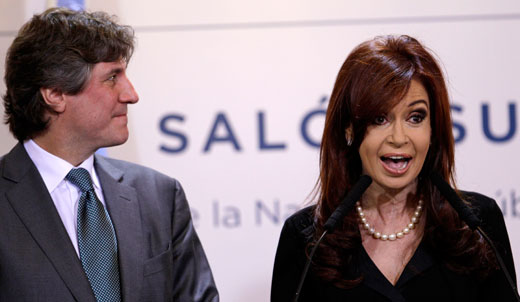
The incumbent president of Argentina, Cristina Fernandez de Kirchner, confounded skeptics and hostile media by doing extremely well in primary elections on August 14. However, supporters warn that the right wing opposition still may have tricks up its sleeve.
Fernandez is the widow of former President Nestor Kirchner, who ruled Argentina from 2003 to 2007. Mr. Kirchner is credited by many for having pulled Argentina out of a terrible economic crisis including a default on international debts, through the “unorthodox” approach of turning away from the “Washington Consensus” neoliberal policies of free trade, privatization and austerity. Instead, he turned his government’s financial resources toward raising the living standard of the Argentine people, to restore internal markets. In spite of doomsayers, Kirchner’s policy was mostly a success, and eventually Argentina was able to renegotiate its debts and restore its relationship to lenders.
The Kirchners’ left-wing faction of the Justicialist (Peronist) Party, the Front for Victory (Frente Para la Victoria) lost control of both houses of the legislature in October 2009 and then ex-President Nestor Kirchner died unexpectedly in October 2010. The two events were touted by the Argentine right as spelling doom for Cristina Fernandez and her center-left policies. The doomsayers seemed to assume that she would not be able to win the elections without her husband by her side, reflecting entrenched patriarchal and even misogynistic attitudes, plus the fantasies of an unrelentingly hostile press.
President Fernandez de Kirchner had pushed through the law creating primary elections in 2009, so this was the first primary ever. In practical terms, this primary did not work the way primaries do in the United States (as internal elections within parties) because the parties still nominated their candidates by traditional means. So the importance of the vote is that it gave an idea of the possible results of the general elections on October 23 rather than deciding who would be the parties’ candidates.
Earlier victories by right wing candidates for the governorships of Buenos Aires and two other important provinces, Cordoba and Santa Fe, led to questions about whether Ms. Fernandez could make it. She did far better than expected, garnering just over 50% of the vote. This represented an overwhelming victory over the next closest candidates, Ricardo Alfonsin (son of former President Raul Alfonsin) of the Radical Civic Union and former President Eduardo Duhalde of the Peronist right, each of whom got about 12%.
In other words, Cristina Fernandez de Kirchner was 38 percentage points ahead of her nearest opponent. Furthermore, she got the largest number of votes in all but one of Argentina’s 23 provinces, plus in Buenos Aires.
In the general elections, to avoid a runoff the leading candidate has to get 45 % of the vote, or 40% plus with a lead of at least 10 points over the nearest competitor. This means that Ms. Fernandez may well win the October elections outright.
Furthermore, it is possible that her party, the Front for Victory, or Peronist left, may win back both houses of the Argentine Congress, making it much easier for her to implement her policies.
Most commentators attributed Ms. Fernandez’s victory to improvements in the living condition of Argentine workers and other ordinary people under her and her husband’s administrations, in spite of various labor and other disputes, especially involving the agricultural sector.
The Communist Party of Argentina supported Cristina Fernandez de Kirchner’s candidacy, through its own united front mechanism, New Encounter (Nuevo Encuentro). Party Secretary General Patricio Echegaray praised the election results, saying, “It should be emphasized that by the [level of] participation and the content of the vote, those sectors who represent the proposal to recreate the Washington Consensus, to return to the policies of the 1990s, have been beaten down.”
However, Echegaray warned that a triumphant attitude that assumes that victory in October is in the bag could represent a danger, and urged the government to go even further in implementing progressive policies.
The election results were also good news for other left and left-center governments and opposition movements in Latin America. Under the Kirchners, Argentina has been a key player in trying to free the region from U.S. economic domination. It has done this by promoting a series of regional economic blocs, including UNASUR and Mercosur in which the Argentine government has played an extremely active role.
Photo: Argentina’s President and candidate for re-election Cristina Fernandez de Kirchner, right, and her Finance Minister and vice-presidential candidate Amado Boudou, at a press conference at the government house in Buenos Aires, Argentina, Aug. 15. (Natacha Pisarenko/AP)










